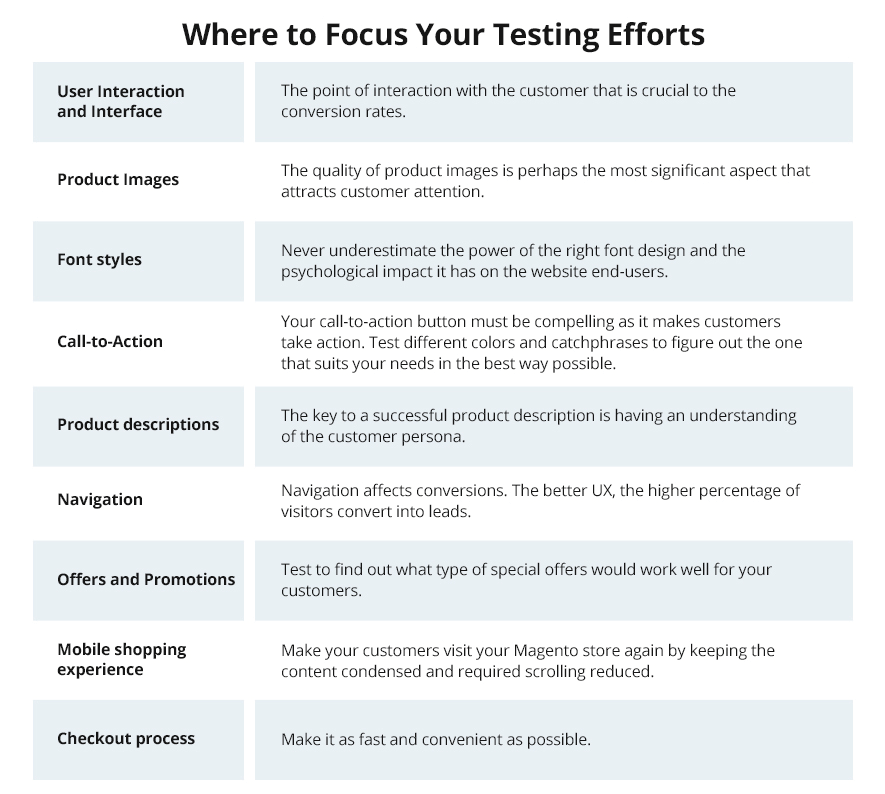E-commerce Software Testing Guide
by Yulia Lomanova | October 26, 2020 1:21 pm
At a time when people around the world are pondering whether they’ll ever be able to spend another weekend at the mall, e-commerce websites and apps have been thriving like never before. Competing over customers, online stores perpetually improve their quality in terms of functionality, performance, security, and usability. Online shopping, after all, should be a joyous experience.
In this article, we’ll discuss testing types that are crucial for securing the quality of e-commerce software.
Usability Testing
Usability defines user satisfaction with a software product in terms of how self-evident and self-explanatory user interface, components, and navigation are. In our fast-paced world, there is no time for unnecessary thinking. Everyone wants to achieve their goals as fast and easily as possible. E-commerce software able to offer the most enjoyable shopping experience will definitely have more chances to win the market.
When it comes to usability testing of e-commerce software, it should undoubtedly cover all the problem areas in the shopping journey. The QA engineer needs to make sure that every product is easy to find, there is enough information available to make an informed purchase decision, and no difficulties occur during the process.
Before initiating the actual testing, there should be a list of precise objectives that contain evaluation measures, target user groups, and a context for website use. The list of key evaluation measures for usability testing includes the rate of successful task completion. time spent on task completion, errors per task, and variance between the predefined path to accomplish a task and the one taken by the user. Users’ overall feelings about a website throughout the testing process is another crucial factor that needs to be considered.
Usability testing with real users is based on them acting according to task scenarios that provide context to engage with the interface. The ideal task scenario is realistic, actionable, and avoids micromanaging every click.
Functional Testing
Functional testing[1] serves to validate how the software product is performing against the functional specifications. When it comes to e-commerce, it should cover the following structural areas:
- Website pages (homepage, product pages, special offers, About Us, privacy policies, News, etc.)
- Search functionality (data correctness, error handling, mobile-friendliness, etc.) Learn more about this topic from our recent article How to Test Online Store Search Functionality[2].
- Product description pages (product title and description, images, related products, Add to Cart feature, etc.)
- Shopping Cart (product list, removing products from the list, delivery options, card payment, pay now option, etc.)
Security Testing
The list of e-commerce security requirements includes server security backed by firewalls and proxy servers, the privacy and integrity of communications between parties, correct authentication and authorization, secure payments, and audit mechanisms.
At the same time, there are numerous security vulnerabilities common for e-commerce systems, such as SQL injection, price manipulation, buffer overflows, cross-site scripting, remote command execution. as well as weak authentication and authorization.
The security testing process includes the exploration of security threats (custom code, network infrastructure, security policies) through various types of security assessment[3], vulnerability prioritization as it helps to focus on the most critical areas first, depth assessment, and, finally, reporting. Security testing reports should be well-structured and understandable for management and dev teams. They also should involve security improvement suggestions and insights on how to harden cybersecurity defenses.
 [4]
[4]
Performance Testing
Performance testing of e-commerce software involves speed examination and may vary according to the testing goals. Checking the website performance under normal conditions requires load testing. It covers the expected average and peak traffic load, while the number of concurrent users is agreed upon before testing.
On the verge of widely advertised sales events, the website or application may require stress testing that would challenge the system with the traffic that exceeds the expected load. The testing scenarios should cover common user activities, such as logging in or signing up for an account, searching for products in the catalog, adding products to the cart, checking out, etc.
Database Testing
Database (or backend) testing validates items generally hidden from the user. It includes internal processes and storage, tables, columns, keys and indexes, stored procedures triggers, database server, and data duplications. It also checks data integrity and consistency.
What is more, it is possible to test a database system with a heavy load using database stress testing. This testing technique allows identifying the breakdown point of the database system and, therefore, making sure it can handle the expected peak traffic load.
A/B testing
A/B testing[5] as a continuous practice is another crucial step towards optimizing the shopping experience. It boils down to comparing two versions of design elements in the same environment to choose the one with the best performance and, consequently, create a product with the highest conversion rate. A/B testing of e-stores allows studying customers’ preferences, improving the KPIs, and applying different SEO practices.
To decide what areas to cover, check out the following table:

Conclusion
While the ever-increasing number of eCommerce businesses try to enter the market as quickly as possible, quality remains key in this challenging time. Stay true to your business aspirations and invest in software testing. That is one thing that always pays off.
Learn more from QATestLab
Related Posts:
- Functional testing: https://blog.qatestlab.com/2020/12/22/functional-test-cases-ecommerce/
- How to Test Online Store Search Functionality: https://qatestlab.com/resources/knowledge-center/search-functionality-testing/
- types of security assessment: https://blog.qatestlab.com/2020/09/07/security-testing-types/
- [Image]: https://qatestlab.com/industries/e-commerce/?utm_source=Blog&utm_medium=Post&utm_campaign=e-commerce
- A/B testing: https://blog.qatestlab.com/2020/07/23/magento-ab-testing/
- The Power of Automated QA in E-Commerce: Speed, Stability, and Success : https://blog.qatestlab.com/2025/10/16/the-power-of-automated-qa-for-e-commerce-speed-stability-and-success/
- Is Your E-commerce Ready for Black Friday & Cyber Monday? Let’s Check!: https://blog.qatestlab.com/2024/11/12/is-your-e-commerce-ready-for-black-friday-and-cyber-monday/
- A Brief Guide to E-commerce Testing Process: https://blog.qatestlab.com/2023/08/16/e-commerce-testing-checklist-2/
Source URL: https://blog.qatestlab.com/2020/10/26/e-commerce-software-testing-guide/

